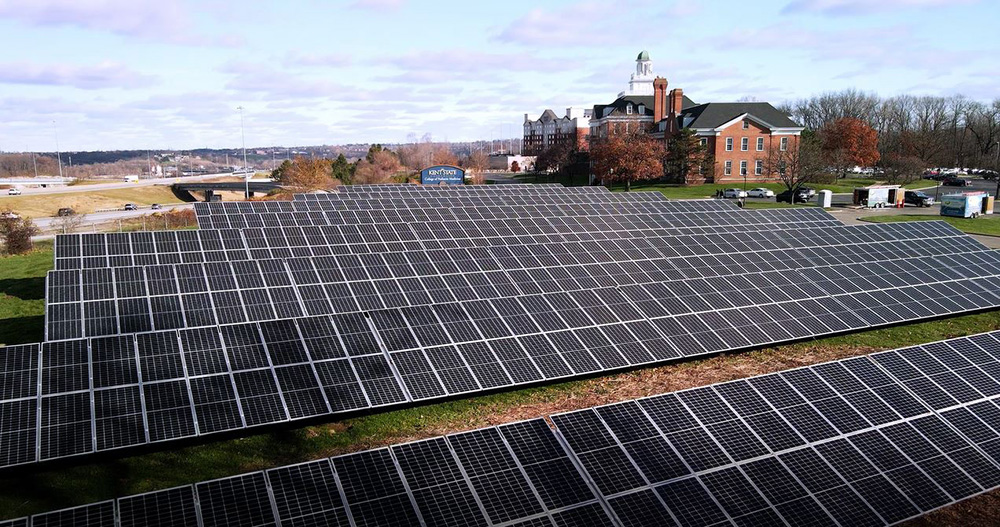by Melanie Knowles and Robert Misbrener
æ≈”Œ”È¿÷πŸÕ¯ (KSU) installed nearly 4 megawatts of ground- and roof-mounted solar panels in the last year and has plans to add up to 6 additional megawatts in the coming year. KSU‚Äôs commitment to alternative energy improves its microgrid capabilities, diversity, and reliability, positioning it for manageable utility costs over the next 25 years. This investment in solar energy aligns with KSU‚Äôs vision: ‚ÄúTo be a community of change agents whose collective commitment to learning sparks epic thinking, meaningful voice and invaluable outcomes to better our society.‚Äù
KSU is a public research university with an enrollment of over 38,000 students and 8 million sq. ft. of building area. The Kent Campus is located on 941 acres in Kent, Ohio, and is one of the largest universities in Ohio, with 11 Leadership in Energy and Environmental Design (LEED)-certified buildings. The university also includes seven regional campuses in northeastern Ohio and additional facilities in the region and internationally.
The State of the Global Climate 2020 report by the World Meteorological Organization of the United Nations (UN), released on April 19, 2021, shows that the previous year was one of the hottest on record. Greenhouse gas concentrations have increased, despite the pandemic-related economic slowdown. At a press conference presenting the details of the report, UN Secretary-General Ant√≥nio Guterres warned that 2021 must be the year of action for protecting people against the ‚Äúdisastrous‚Äù effects of climate change: ‚ÄúTime is fast running out to meet the goals of the Paris Agreement. We need to do more, and faster, now.‚Äù æ≈”Œ”È¿÷πŸÕ¯ is proud to be doing more, and faster‚Äînow‚Äîto reduce our carbon footprint.
Solar power is an important component to a more sustainable, carbon-free, and cooler energy future. The carbon footprint needed to produce, ship, and install solar panels is often referenced to be offset in about 3 years of operation. Solar panel operational lifespan is over 25 years. While solar is increasingly attractive, the decision of when and where to implement it can be complex. At a public university where the priority is to support students and research, the financial benefit (or at least neutrality) of such a measure must be solid. The university must be a good steward of tuition dollars while advancing sustainability.
æ≈”Œ”È¿÷πŸÕ¯ has worked to address energy at multiple levels. The first priority is to reduce demand. Energy-efficiency retrofits have reduced our energy consumption by about 24% at our Kent campus and about 34% at our regional campuses. Energy-efficiency campaigns such as the annual residence-hall competition ‚ÄúDo It in the Dark,‚Äù along with reminders to turn off and unplug during peak load days and over breaks, support energy-saving behavior change. For the energy that is still required, we then consider its source.
The power system in our region has multiple layers affecting the production and purchase of electricity. There are organizations that coordinate the activities of the electric power system, and organizations that generate, transmit, and distribute the electricity for customer consumption. In some areas these functions are done by a single organization. Customers are denoted as electric loads.
Some customers purchase all their electricity requirements from the electric grid. Others self-generate a portion (sometimes all) of their electricity requirements and purchase the remainder from the electric grid. KSU self-generates a portion of our electricity requirements and purchases the balance from the electric grid. We use natural-gas-fired combustion turbines and capture the heat from them to produce steam for campus heating and cooling use. This suite of technologies is known as a combined heat and power (CHP) plant and is one of the most efficient means of energy use. We received the U.S. Environmental Protection Agency (EPA) Energy Star Combined Heat and Power Award in 2007.

æ≈”Œ”È¿÷πŸÕ¯ College of Podiatric Medicine, 315.2-kWdc solar photovoltaic (PV) array. Ground, fixed-tilt mounting.
The Federal Energy Regulatory Commission (FERC) has jurisdiction/regulation over certain portions of the overall electric power system. The next level of jurisdiction/regulation after FERC are the regional transmission organizations (RTOs), and the next level after RTOs is typically the state public utilities commission. In Ohio, this is the Public Utilities Commission of Ohio
